Best of India Tours
- Golden Triangle Tour- Best of India & Nepal
- Classical Rajasthan
India Cultural Tours
- Images of North India- Karnataka Heritage
- Rajasthan & Goa Tour
Discover India Tours
- Grand India Tour- North to South India
- Central to South India
Rajasthan Tours
- Classical Rajasthan Tour- Golden Triangle Tour
- Grand Mughal Tour
India Luxury Trains
- Palace on Wheels- The Golden Chariot
- India Deccan Odyssey
- The Indian Maharaja
- Royal Rajasthan on Wheels
Nepal Tours
- Glimpses of Nepal- Buddhist Pilgrimage
- Nepal River Rafting
- Destinations of Nepal
- Nepal General Info
India Wildlife Tours
- North India Wild Life- South India Wildlife
Tibet Tours
- Tibet Monastery Tours- Explore Tibet
- Destinations of Tibet
Spa & Yoga Tours
- Ananda in Himalayas- Yoga & Meditation
Adventure Tours
- Manali Safari Tour- Himalayan Trekking
- Horse Safari
Mandu
Bandhavgarh
![]() Bhopal
Bhopal
![]() Gwalior
Gwalior
![]() Indore
Indore
![]() Jabalpur
Jabalpur
![]() Kanha
Kanha
![]() Khajuraho
Khajuraho
![]() Mandu
Mandu
![]() Orchha
Orchha
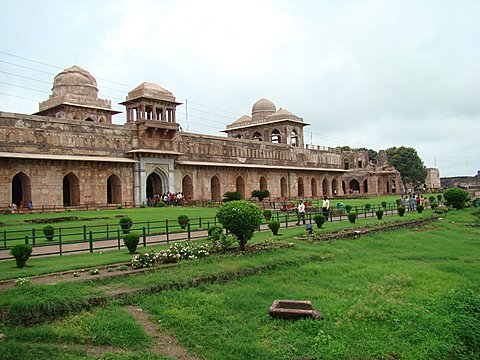
Mandu, or the ”City of Joy”, is a superb hilltop fort, deserted, dramatic, and alive with ghosts! It is a dream city steeped in legends of the love of Baz Bahadur for his beloved Rani Roopmati. Breathtakingly beautiful, this former capital of the Sultanate of Malwa is perched high on a hill in the central Indian state of Madhya Pradesh, 283 km away from the capital city Bhopal. A ghost city now, Mandu was once the monsoon retreat of the Mughal emperors. For one thing, Mandu is far from the coast. It does not have the sort of sluicing rain that inundates some of our seaboard destinations.
Moreover, Mandu is on a plateau and regardless of how much it rains, the water pours off in silver-threaded waterfalls which gives it a sort of designer magic that no designer but only nature can replicate. And finally—and this is a big plus—many of the monumental buildings of Mandu have been fashioned to use this play of water and rain-heavy thunder clouds to superb effect.
You’ll get an inkling of what you should expect in Mandu when you drive through the sub-montane lands that lead up to the plateau. Rising out of the tangles of scrub vegetation are no-nonsense, foursquare, staging posts for horse-mounted messengers and guardhouses. Some of them have domes which look rather like the qullas, or foundation caps around which some turbans are tied. Then the road winds up and pierces the edge of the escarpment through a succession of massive gates. It is only then that one enters the hamlet of Mandu flowing through the old monuments. The living hamlet and the well-preserved ruins now form a seamless whole and it is virtually impossible to see where one ends and the other begins.
Sightseeing
Mandu has over 40 monuments to choose from. For convenience, these are divided into three broad groups: the Central Village Group, the Royal Enclave Group, and the Rewa Kund Group. You can easily spend all day in Mandu, wandering in and out of palaces, pausing to admire the beauty of the Champa Baoli, the former baths, and the huge 15th-century Jami Masjid, the finest example of Afghan architecture in India. Then there are the beautiful Jahaz Mahal (ship palace), where the architectural illusion is completed by the two surrounding lakes; the Hindola Mahal, or swing palace; the romantic Baz Bahadur's Palace and Roopmati's Pavilion; and Hoshang Shah’s Tomb, the final resting place of the founder of Ghuri Dynasty. Besides, there are many palaces, pavilions, and reservoirs where you can spend a leisurely day taking in the city’s rather turbulent history, which is not revealed by the monuments that speak of luxurious royal lifestyles.
Excursions
Mandu can be made the base for visiting several important destination of south Madhya Pradesh. The Bagh Caves (50 km) are Buddhist viharas that were excavated on the perpendicular rock face of a hill. Of particular interest here are the mural paintings drawn by master painters of ancient India. Another religious place near Mandu is Omkareswar. The site of the famous Omkareswar Mahadeo temple, Omkareswar houses one of the 12 jyotirlingas of India. Then there is Maheshwar, a temple city that finds mention in the Mahabharata and Ramayana. The Mahishmati of yore, Maheshwar is also a household name for its unique Maheshwari saris.
Excursions for Mandu
Jami Masjid
Built in 1454, the Jami Masjid is by far the most majestic building in Mandu. It is said that the builders had designed it after the Omayyed Mosque of Damascus. The best view of this monument can be had from the Ashrafi Mahal rising in front of it. Do, however, go inside. Wander around, examine the decorations on the lintel of the doorway, the jali (filigree) screens and the curious little domes of the prayer hall, which are believed to be acoustic devices to amplify voices and absorb echoes.
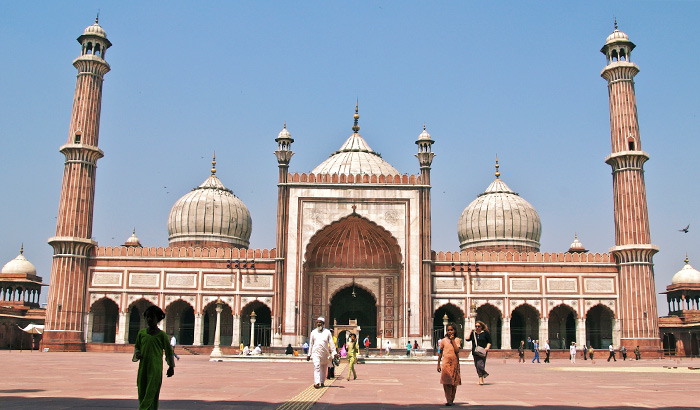
Hoshang Shah's Tomb
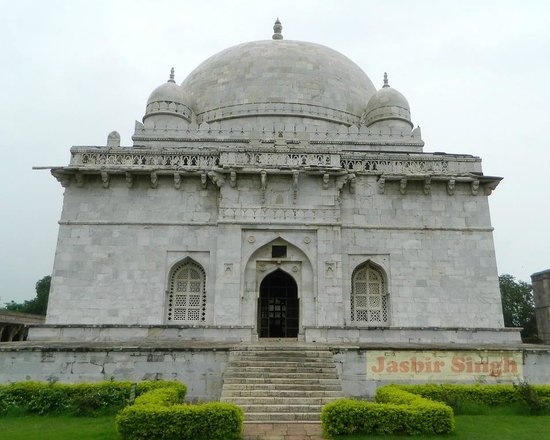
From the Jami Masjid, move on to the tomb of Hoshang Shah: a massive, foursquare monument with a huge dome. Constructed in AD 1435, it is reputed to be the oldest marble structure in India and depicts typical Hindu influences including carved marble lattice screens (jali). An inscription on the right jamb of the door mentions the name of Ustad Hamid who was involved with the building of the Taj Mahal in Agra.
Ashrafi Mahal
Ashrafi Mahal was originally built as a madarsa (a Muslim religious school), but later extended to become Mohammed Shah’s tomb. Now only the ruins of this building are visible.
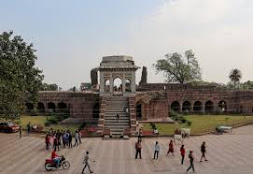
Jahaz mahal
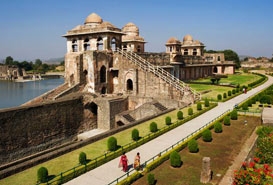
One of the most popular monuments in Mandu, this ship-like structure was constructed by Ghiyas-ud-din, son of Mohammed Shah, for his harem. According to the legends, this harem was home to 15,000 maidens. There are two lakes on the east and west side of the palace that create a perfect illusion of a ship with its rectangular shape.
Hindola Mahal
Near the Jahaz Mahal is the unusual Hindola Mahal (or Swing Palace). It’s a large hall supported by sloping buttresses which, presumably, resembled the supports of a swing. According to local legends, both the Jahaz and Hindola Mahal were popular with the Mughals who had parties here on monsoon evenings.
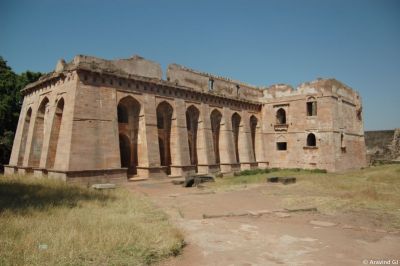
Champa Baoli
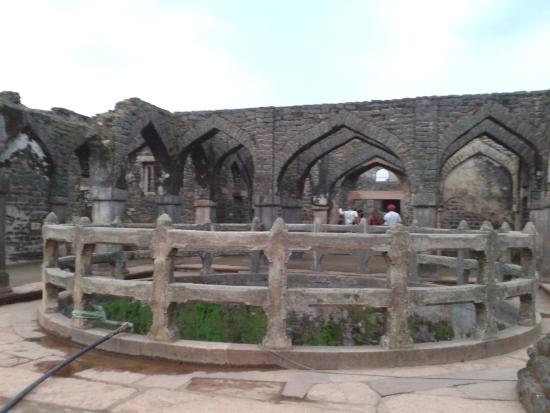
Champa Baoli is an interesting step-well on the north edge of the tank situated there. It was a popular hot-weather retreat and featured cool wells and bathrooms.
Taveli Mahal
Taveli Mahal is located just south of Jahaz Mahal and now houses the antiquity gallery of the Archaeological Survey of India.
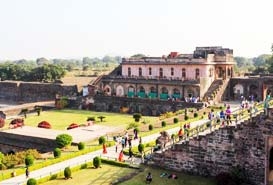
Baz Bahadur's Palace
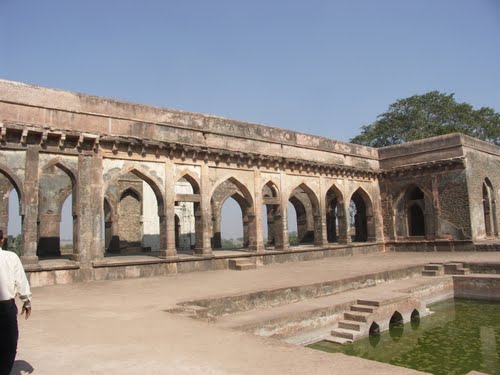
The Rewa Kund is actually a tank of sacred water from the river Rewa, another name for the Narmada. This is the place where the love of poet-prince Baz Bahadur and Rani Roopmati flowered. Baz Bahadur was the last independent king of Malwa who fell in love with an ordinary shepherdess called Roopmati. Unfortunately, their love had a tragic end when the great Mughal emperor, Akbar, spurned by Roopmati’s beauty, attacked Mandu and Baz Bahadur fled Mandu leaving his lover to poison herself. Baz Bahadur’s Palace was constructed in 1509 beside the Rewa Kund, well before he became the king. The palace displays a curious mix of Rajasthani and Mughal style of architecture. There was a water lift at the northern end of the tank to supply water to the tank.
Roopmati's Pavilion
Roopmati’s Pavilion, looking out over the distant river valley of the Narmada, is situated on the very edge of Mandu Fort. It is a very romantic building, a perfect setting for fairytale romance. From the pavilion at the end of the terrace of this palace you feel as if you are standing on the prow of a great ship, surging through a rising sea of clouds, with water streaming away in cascades as you ride the swell of your imagination. It’s a heady feeling!
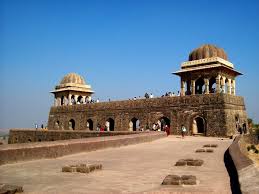
Nilkanth Temple
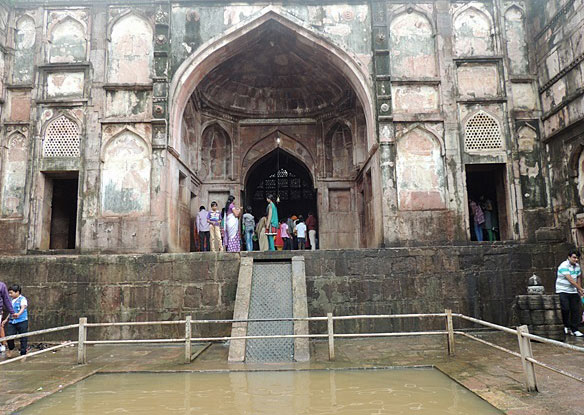
Nilkanth (literally, the blue-throated one; another name of Lord Shiva) is a shrine dedicated to Shiva, the destroyer of the Hindu Trinity. Located on the edge of a steep gorge, the shrine is still visited by pilgrims.
Fact File
 Area: 20 sq. km
Area: 20 sq. km
 Population: 5,000
Population: 5,000
 Altitude: 634 m above sea level
Altitude: 634 m above sea level
 Best Time to Visit:July to September
Best Time to Visit:July to September
 Languages:Hindi and English
Languages:Hindi and English
 STD Code: 07292
STD Code: 07292




